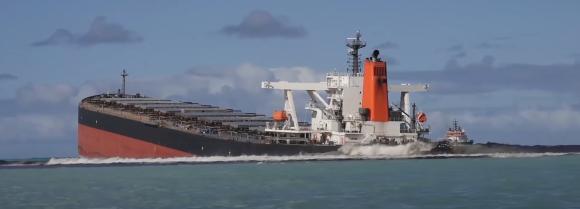
On July 25, the MV Wakashio ran hard aground on a coral reef in Mauritius. The large capesize bulker was bound From China to Brazil to load cargo and was empty, operating in ballast when it struck the reef. On August 6, after 13 days aground, the ship began to leak fuel oil. Over 1,000 tonnes of 4,000 tonnes aboard leaked into the pristine waters. The grounding took place off of Pointe d’Esny, near the marine park of Blue Bay. Mauritius is home to world-renowned coral reefs, and tourism is a crucial part of its economy.
Mitsui OSK, the ship operator, supported by a French pollution-control team and the Mauritius Coast Guard, has been working to pump out the remaining fuel oil before the ship breaks up. Today, the Mauritius Prime Minister Pravind Jugnauth announced that almost all the fuel oil remaining aboard the ship has been pumped out.
The BBC reports that Mr. Jugnauth declared a state of emergency on Friday and appealed for international help.
Since then, volunteers have also been collecting straw from fields and filling sacks to make barriers against the oil.
Greenpeace Africa has warned that “thousands” of animal species were “at risk of drowning in a sea of pollution, with dire consequences for Mauritius’ economy, food security, and health”.
An oceanographer and environmental engineer in Mauritius, Vassen Kauppaymuthoo, told the BBC that local residents were now “breathing heavy vapors of oil”, and there was a “mixture of sadness and anger” over the spill.
Thanks to Phil Leon and David Rye for contributing to this post.
Clean-up operation underway after oil spill off coast of Mauritius

So if the weight of the cargo is removed. Shouldnt the ship be relatively stable to be hauled to a port for repairs? Or is the ship on a reef causing her stern to sink?
Seems like if the weight is removed the ship should become more boyant and less prone to sinking.
Nvm, I see in the article it is on a reef. My bad
Hi Rick
Responses are not showing!
For some strange reason the replies are not showing up?
I read the locals were using plastic bottles, sugarcane leaves and cutting their hair to catch the oil wrapped up in canvas tubes.
I read that on the Exxon Valdize they pumped the oil out of the non ruptured tanks first which raised the ship and allowed even more oil to escape from the ruptured tanks.
Source: The Tankship Tromedy by Jack Devanney
I hope this book is essential reading for all salvage people.